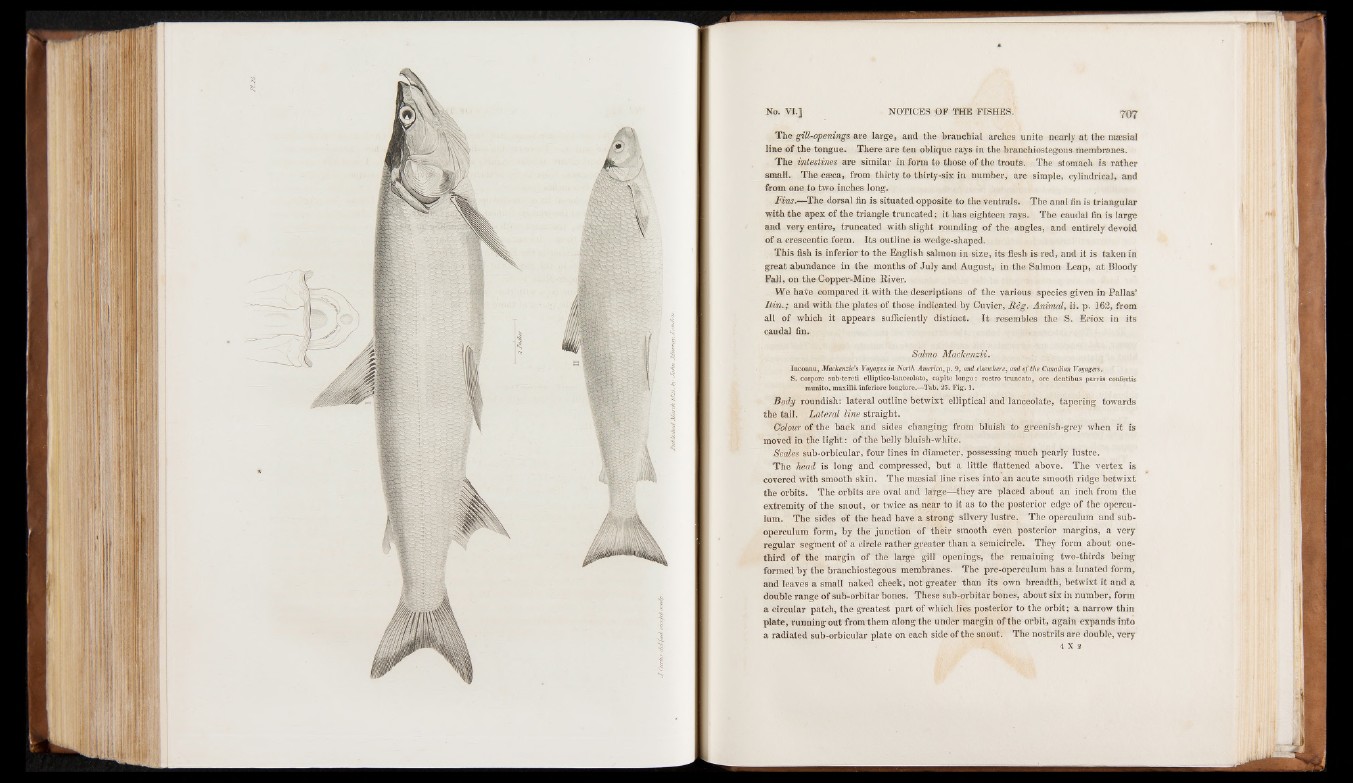
No. VI.] NOTICES OF THE FISHES. 707
The gill-openings are large, and the branchial arches unite nearly at the msesial
line of the tongue. There are ten oblique rays in the branchiostegous membranes.
The intestines are similar in form to those of the trouts. The stomach is rather
small. The caeca, from thirty to thirty-six in number, are simple, cylindrical, and
from one to two inches long.
Fins.—The dorsal fin is situated opposite to the ventrals. The anal fin is triangular
with the apex of the triangle truncated; it has eighteen rays. The caudal fin is large
and very entire, truncated with slight rounding of the angles, and entirely devoid
of a crescentic form. Its outline is wedge-shaped.
This fish is inferior to the English salmon in size, its flesh is red, and it is taken in
great abundance in the months of July and August, in the Salmon Leap, at Bloody
Fall, on the Copper-Mine River.
We have compared it with the descriptions of the various species given in Pallas’
Itin.; and with the plates of those indicated by Cuvier, Reg. Animal, ii. p. 162, from
all of which it appears sufficiently distinct. It resembles the S. Eriox in its
caudal fin.
Salmo Mackenzii.
Inconnu, Mackenzie’s Voyages in N orth America, p. 9, and elsewhere, and o f the Canadian Voyagers.
S. corpora sub-tereti elliptico-lanceolato, capite longo: rostro truncato, ora. dentibus parvis confeitis
munito, maxilla inferiore longiore.—Tab. 25. Fig. 1.
Body roundish: lateral outline betwixt elliptical and lanceolate, tapering towards
the tail. Lateral line straight.
Colour of the back and sides changing from bluish to greenish-grey when it is
moved- in the light: of the belly bluish-white.
Scales sub-orbicular, four lines in diameter, possessing much pearly lustre.
The head is long and compressed, but a little flattened above. The vertex is
covered with smooth skin. The maesial line rises into an acute smooth ridge betwixt
the orbits. The orbits are oval and large—they are placed about an inch from the
extremity of the snout, or twice as near to it as to the posterior edge of the operculum.
The sides of the head have a strong silvery lustre. The operculum and suboperculum
form, by the junction of their smooth even posterior margins, a very
regular segment of a circle rather greater than a semicircle. They form about one-
third of the margin of the large gill openings, the remaining two-thirds being
formed by the branchiostegous membranes. The pre-operculum has a lunated form,
and leaves a small naked cheek, not greater than its own breadth, betwixt it and a
double range of sub-orbitar bones. These sub-orbitar bones, about six in number, form
a circular patch, the greatest part of which lies posterior to the orbit; a narrow thin
plate, running out from them along the under margin of the orbit, again expands into
a radiated sub-orbicular plate on each side of the snout. The nostrils are double, very
4 X 2